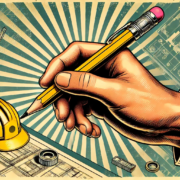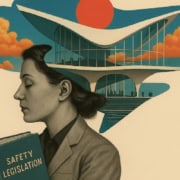Role of Designers in Safety: The Upstream Duty Holders
by Leo Fan — Senior Risk Consultant at Safe Design Australia
When we think about safety, most of us picture what happens on-site — helmets, harnesses, high-risk work. But safety actually starts much earlier, and often in a place people don’t expect: the design stage.
But the Code of Practice: Safe Design of Structures makes it clear — designers carry upstream responsibility and directly shape how safely a structure is built, used, maintained, and ultimately demolished. For designers, the key idea is that safety in design isn’t just a legal duty — it’s a mark of professional integrity.
As the originators of every concept, designers have both the opportunity and the responsibility to embed safety from the outset, setting the standard for good practice and protecting everyone who interacts with the structure throughout its life.
So, who is a ‘designer’?
It’s not just the architect or the engineer. The role of designer for safety in design purposes could be:
- Anyone creating or modifying a structure
- Someone introducing changes to the design during construction, or even
- People involved in upgrades later on
The catch? Many designers don’t realise they carry this responsibility!
Responsibility vs influence
Under WHS law, designers have a legal duty to eliminate or minimise risks “so far as is reasonably practicable.” That means they can’t pass the buck downstream to the contractor or site team.
But beyond compliance, designers hold practical influence that goes much further. Every design decision you make — from layout and materials to access points — shapes how safely your structure can be built, operated, and maintained.
Every line drawn, every choice made, can either prevent a hazard or invite one. That’s the true power of good design — it shapes safety long before anyone steps on site. We explored this idea further in Safety in Design as a Creative Force — where innovation and safety mesh together to inspire better outcomes.
Designing safety for people who don’t exist yet — that’s not just compliance.. it’s cleverly calculated Safety in Design collaboration.
Safety leadership in design
Designers aren’t just ticking boxes for compliance — they’re setting the tone for safety. That means proactively identifying risks, calling out hazards, and embedding safety into drawings and documentation.
Before anyone lifts the first beam or digs the first trench, designers are already building — or compromising — safety with the choices they make on paper.
Practical tools and case studies that help you apply these principles in your projects are available in our free Safe Design eBook.
Collaboration in Designing for Safety
Leadership sets the direction, but designers can’t work in isolation. That’s why Safety in Design Workshops are so valuable. These conversations bring together principal contractors, operators, and maintainers to make sure risks are identified and addressed before they become problems on site.
In these workshops, the paper plans meet real-world experience — and that’s where the best design solutions are born. Workshop conversations turn abstract risks into real understanding — giving every stakeholder a hand in designing safety in from the start, not patching it on later.
More than legal duties
Yes, designers have safety in design duties to discharge under WHS laws. But their real superpower lies in deploying imagination. When safety becomes part of the creative process — not just an afterthought — it fuels better ideas, smarter structures, and a culture others naturally follow. WHS laws set the baseline, but great designers go beyond it.
At the end of the day…
Safety ALWAYS starts with design. If designers step up as leaders, engage openly, and design with safety front of mind they shape not just buildings, but lives lived decades from now — safeguarding every hand that will ever touch their work.
That’s the ultimate role of designers as upstream duty holders — crafting safety and positively influencing futures at the design stage. from the first worker on site to the last person maintaining the structure in the far off future. Responsibility discharged well is anything but boring.
Safety starts with design AND a conversation. Read more about the Safe Design Australia approach to Safe Design or get in contact for a 15minute brainstorm with one of our senior consultants.

 © Safe Design Australia, 2025. Image generated with AI and edited for publication.
© Safe Design Australia, 2025. Image generated with AI and edited for publication.
 Safe Design Australia 2025
Safe Design Australia 2025